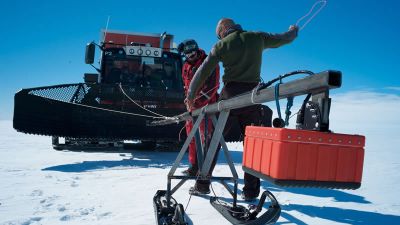
BELISSIMA: Understanding Ice Dynamics
This glaciology project aims at analysing ice shelf and ice sheet movements and dynamics in Antarctica in order to improve scientific models. The Antarctic Ice Sheets is the biggest ice mass of our planet and it could have a big impact on sea level rise.
As it moves off the continent and onto the ocean, the ice can become an ice shelf (ice that floats on the water yet remains attached to the ice sheet), at the end of which icebergs (blocks of ice floating on the water) calve off. As we know from Archimedes' Principle, the point at which the ice starts to touch the water is the point at which ice form the ice sheet starts to have an influence on sea level. As long as an ice shelf is present, it slows down the ice from the interior of the ice sheet as it flows towards the ocean. Yet the increase of the melt rate at the anchor point increases the rate at which the ice flows towards the ocean, something which ultimately contributes to sea level to rise.
The interest of such a study is ultimately to improve predictive mathematical models, taking into account the different parameters of the ice sheet. Don't forget that the loss of ice into the ocean contributes to sea level rise, so it's essential to understand ice dynamics and the formation of icebergs in order to better predict how sea level will rise in the next 100 or 200 years.
Frank Pattyn (ULB), Jean-Louis Tison (ULB) and a team of three international glaciologists travelled close to the Antarctic coast in the vicinity of Breid Bay in order to study the underside of the Antarctic Ice Sheet.
Picture: Installing the BELISSIMA radar - © International Polar Foundation
